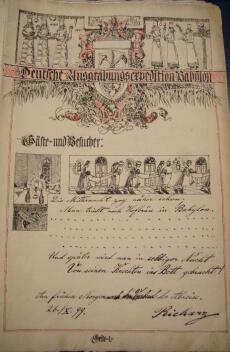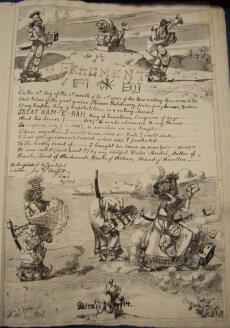The guestbook of the German excavations in Babylon (1899-1917)

by Georg Neumann
Writing about the excavations in Babylon in a volume on Robert Koldewey, one of the main excavators of the city of Babylon, Joachim Marzahn stated that breaks while excavating were not scheduled, holidays were rare or non-existent, and that while women were frowned upon at the excavation, guests were welcome (“eine Arbeitspause […] (bei den Ausgrabungen war) nicht vorgesehen, Urlaub gab es gar nicht oder selten. Frauen waren auf der Grabung verpönt, Gäste dagegen sah man gern.”). These welcome guests are documented in the guestbook of the excavations in Babylon owned by the Deutsche Orient-Gesellschaft e.V. (DOG). This guestbook extends over more than 270 pages, covering the period from 1899 until 1917. It provides a unique source for the tumultuous history of the late 19th and early 20th centuries CE, with a special focus on the Near East. Guests from all over the world visited the excavations in the ancient metropolis of Babylon. Whoever travelled Iraq during these years simply had to visit Babylon, and whoever stayed there for more than a day was pushed to register – sometimes quite creatively – in the excavation’s guestbook, according to an entry by Paul Behrenz on June 10th, 1906 (“Wer mehr als einen Tag hier weilt, / Den hat das Schicksal schon ereilt. / Der muss, um hier sich einzutragen, / Sich mit Gedichte-Machen plagen.” / (So sagt mir eben der Herr Reuther) ...”). The entries in the visitors’ book were written in German, French, English, Italian, Arabic, Hebrew, Ancient Greek and Hungarian – in addition to notes in cuneiform.

The guestbook contains information not only on contemporary and cultural history, but also on the history of scholarship. At the agency of the DOG, this important source will now be published as a contextualised edition. The core of this edition consists of a transcription and a translation of individual texts. These are enriched by a contextual information on the individual entries, demonstrating their importance for contemporary history. In addition, the edition will contain short biographies and photographs of the individual authors whenever possible, making these people more easily accessible to the modern reader. Aside from written entries, the guestbook also contains drawings, aquarelles, and even “comics”, in part stretching over several pages. These will be published through photographs. A thorough introduction will accompany this edition, providing material on the contemporary history, culture, politics, and society of the Near East as well as information about Babylon, more generally and specific to the excavations.
The principal investigator of this project is Dr. des Georg Neumann. Prof. Dr. Hans Neumann will also contribute to the edition.
Further reading
G. Neumann, “Die Mitternacht zog näher schon. Man trinkt noch Hofbräu in Babylon...und später wird man in selbiger Nacht von seinem Knecht ins Bett gebracht!” – Some Insights to the Guest Book of the German Excavations in Babylon, in: K. Droß-Krüpe – A. Garcia-Ventura – K. Ruffing – L. Verderame (Hg.), Orientalist Gazes. Reception and Construction of Images of the Ancient Near East since the 17th Century (wEdge 3. Münster 2023) 87-114. Free PDF Download
G. Neumann, “Ausgraben einmal anders. Das Gästebuch der deutschen Ausgrabungen in Babylon,” Alter Orient aktuell 11 (2010) 4-7.
K. Kohlmeyer, E. Strommenger, H. Schmid (eds), Wiedererstehendes Babylon. Eine antike Weltstadt im Blick der Forschung, Berlin 1991.
J. Marzahn, “Robert Koldewey – Ein Lebensbild,” in: R.-B. Wartke (ed.), Auf dem Weg nach Babylon. Robert Koldewey – Ein Archäologenleben, Mainz 2008, 8-27.
R.-B. Wartke, “Babylon vor 100 Jahren (Juli-September 1914),” in: Antike Welt 4/2014, 45-47.
